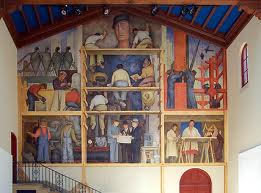Matisse says, “What I am after, above all, is expression…I am unable to distinguish between the feeling I have for life and my way of expressing it.”

 Henri Matisse was a French artist recognized as a leading figure in modern art in the 20th Century along side Picasso and Duchamp. He is known for his use of color. His subjects most frequently painted were still life and women, and he painted from nature and not from the imagination, he would place his subjects in real interiors. I have two of my favorite works by Matisse here to discuss.
Henri Matisse was a French artist recognized as a leading figure in modern art in the 20th Century along side Picasso and Duchamp. He is known for his use of color. His subjects most frequently painted were still life and women, and he painted from nature and not from the imagination, he would place his subjects in real interiors. I have two of my favorite works by Matisse here to discuss.Lets take a look at: “Interior with a Violin Case” 1918. Oil on Canvas
In this painting you see the colorist painter in Matisse, also see that he used bold outlines around his shapes. In this painting you look into this room and carry your view out of the window, then back into the room where you see no person, but you notice the violin case on the chair, and it is empty, where is the violin? With no human subject in this artwork you cannot help but wonder if the sound of the violin can be heard through the open window. You wonder, has the owner of this violin opened his case and escaped to the streets below to play his instrument, the open case allures us to think or wonder where the violin could be and why the window is open. The room seems freshly lived in rather then still with no life. The sun is piercing through the window, the streaming light fills this room with life. Matisse interacts with the viewer here and gives us a full escape into this painting. Do you feel the life in this painting, and does the room seem to be occupied? How does this painting make you feel?
My number favorite painting by Matisse is his Oil on canvas, Dance (1) 1909.
In this favorite painting of my, I admire the movement is this painting, and the joy and fun that is relays to the viewer. These five ladies are on a high grassy knoll, with blue sky behind them and they dance with hands joined, or almost joined. If you notice the fingers on the bottom center is almost touching, while reaching for the other figure on her left, and this slightly breaks the chain. She extends toward her companion to her left, as she simultaneously pulls hard on the hand of the figure to her right, now notice the legs of this figure in the front they are off balance while she reaches, and the two on top of the hill have their knees bent and their shoulder raised forming this circle that our eyes follow round and round. Dance has movement and beautiful bold colors that give the viewer the sense of joy and fun time.
Matisse died in 1954, with a title as one of our greatest.











